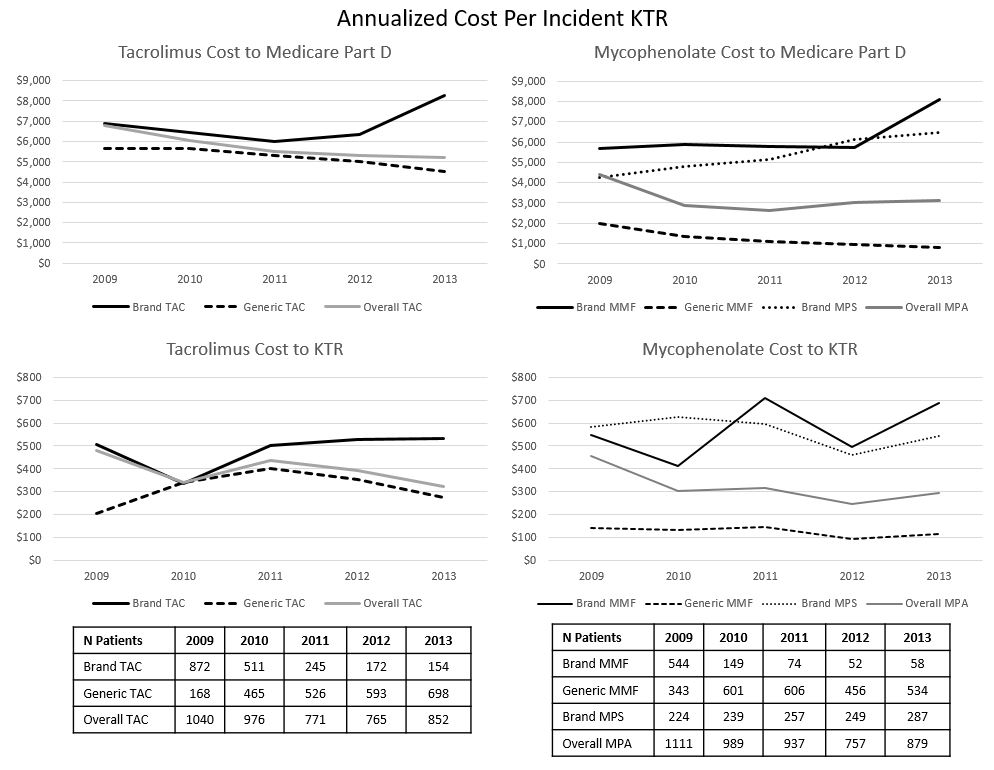Immunosuppressant Costs for Medicare Part D and Kidney Transplant Recipients Since the Introduction of Generic Formulations in an Incident Kidney Transplant Population.
1Arbor Research Collaborative for Health, Ann Arbor, MI
2U of Michigan, Ann Arbor, MI
3Food and Drug Administration, Silver Spring, MD
4U of Virginia, Charlottesville, VA
Meeting: 2017 American Transplant Congress
Abstract number: B159
Keywords: Immunosuppression, Kidney, Medicare, Pharmacoeconomics
Session Information
Session Name: Poster Session B: Kidney Complications II
Session Type: Poster Session
Date: Sunday, April 30, 2017
Session Time: 6:00pm-7:00pm
 Presentation Time: 6:00pm-7:00pm
Presentation Time: 6:00pm-7:00pm
Location: Hall D1
Background: Substitution of generics (GEN) for brand name (BN) immunosuppressants (IS) has increased in kidney transplant recipients (KTR) since the introduction of GEN mycophenolate mofetil (MMF) in 2008 and GEN tacrolimus (TAC) in 2009. Our aim was to determine how increased use of GEN IS has provided savings to the Medicare Part D program (Part D) and to incident KTR.
Methods: Part D claims were linked to the Scientific Registry of Transplant Recipients to identify KTR between 2008 and 2013 who had IS claims paid by Part D within the first year of their transplant. GEN, BN and overall IS costs were compared for TAC and mycophenolic acid (MPA). MPA was further stratified into MMF and mycophenolate sodium (MPS). Only BN costs are included for MPS due to minimal GEN MPS use during the study period. Costs are presented as the annualized average cost per patient to either Part D or KTR in a given year.
Results: Among 5190 incident KTR, 3702 (71%), 2945 (57%) and 1126 (22%) had at least one claim for TAC, MMF and MPS, respectively. Comparing 2009 to 2013, the average annualized overall costs of TAC and MPA declined by over 20% for both Part D and KTR. Since 2010, overall IS costs to Part D have been modestly down-trending (TAC) or stable (MPA). Overall and GEN IS costs to KTR for MPA have been stable since 2010. TAC costs to KTR peaked in 2011, and since have been trending downward. In general, the gap between BN IS and GEN IS costs has increased over the study interval.
Conclusion: The introduction of GEN IS provided cost savings to both incident KTR and Part D. Early in the study period, overall IS costs are close to BN IS costs. With increasing substitution of GEN IS, overall costs more closely parallel GEN IS costs. The preponderance of savings appeared early after GEN IS introduction.
CITATION INFORMATION: Helmuth M, Turenne M, Park J, Liu Q, Oguntimein M, Dutcher S, Balkrishnan R, Zee J, Smith A, Leichtman A. Immunosuppressant Costs for Medicare Part D and Kidney Transplant Recipients Since the Introduction of Generic Formulations in an Incident Kidney Transplant Population. Am J Transplant. 2017;17 (suppl 3).
To cite this abstract in AMA style:
Helmuth M, Turenne M, Park J, Liu Q, Oguntimein M, Dutcher S, Balkrishnan R, Zee J, Smith A, Leichtman A. Immunosuppressant Costs for Medicare Part D and Kidney Transplant Recipients Since the Introduction of Generic Formulations in an Incident Kidney Transplant Population. [abstract]. Am J Transplant. 2017; 17 (suppl 3). https://atcmeetingabstracts.com/abstract/immunosuppressant-costs-for-medicare-part-d-and-kidney-transplant-recipients-since-the-introduction-of-generic-formulations-in-an-incident-kidney-transplant-population/. Accessed December 13, 2025.« Back to 2017 American Transplant Congress
